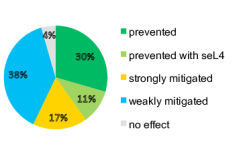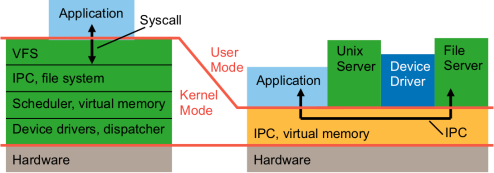We are thrilled to re-post this microkerneldude blog post –Random rants and pontifications by Gernot Heiser

Many of us operating systems researchers, going back at least to the US DoD’s famous 1983 Orange Book, have been saying that a secure/safe system needs to keep its trusted computing base (TCB) as small as possible. For system of significant complexity, this argues for a design where components are protected in their own address spaces by an underlying operating system (OS). This OS is inherently part of the TCB, and such should itself be kept as small as possible, i.e. based on a microkernel, which comprises only some 10,000 lines of code. Which is why I have spent about a quarter century on improving microkernels, culminating in seL4, and getting them into real-world use.

Monolithic vs microkernel-based OS structure.
It is intuitive (although not universally accepted) that a microkernel-based system has security and safety advantages over a large, monolithic OS, such as Linux, Windows or macOS, with their million-lines-of-code kernels. Surprisingly, we lacked quantitative evidence backing this intuition, beyond extrapolating defect density statistics to the huge TCBs of monolithic OSes.
Finally, the evidence is here, and it is compelling
Together with two undergraduate students, I performed an analysis of Linux vulnerabilities listed as critical in the Common Vulnerabilities and Exposures (CVE) database. A vulnerability is tagged critical if it I easy to exploit and leads to full system compromise, including full access to sensitive data and full control over the system.
For each of those documented vulnerabilities we analysed how it would be affected if the attack were performed against a feature-compatible, componentised OS, based on the seL4 microkernel, that minimised the TCB. In other words, an application running on this OS should only be dependent on a minimum of services required to do its job, and no others.
We assume that the application requires network services (and thus depend on the network stack and a NIC driver), persistent storage (file system and a storage device driver) and console I/O. Any OS services not needed by the app should not be able to impact its confidentiality (C), integrity (I) and availability (A). For example, an attack on a USB device should not impact our app. Such a minimal TCB architecture is exactly what microkernels are designed to support.
The facts
The complete results are in a peer-reviewed paper, I’m summarising them here. We find that of all of the 115 critical Linux CVEs, we could analyse 112, the remaining 3 did not have enough information to understand how they could be mitigated. Of those 112:
- 33 (29%) were eliminated simply by implementing the OS as a componentised system on top of a microkernel! These are attacks against functionality Linux implements in the kernel, while a microkernel-based OS implements them as separate processes. Examples are file systems and device drivers. If a Linux USB device driver is compromised, the attacker gains control over the whole system, because the driver runs with kernel privileges. In a well-designed microkernel-based system, only the driver process is compromised, but since our application does not require USB, it remains completely unaffected.
- A further 12 exploits (11%) are eliminated if the underlying microkernel is formally verified (proved correct), as we did with seL4. These are exploits against functionality, such as page-table management, that must be in the kernel, even if it’s a microkernel. A microkernel could be affected by such an attack, but in a verified kernel, such as seL4, the flaws which these attacks target are ruled out by the mathematical proofs.
Taken together, we see that 45 (40%) of the exploits would be completely eliminated by an OS designed based on seL4! - Another 19 (17%) of exploits are strongly mitigated, i.e. reduced to a relatively harmless level, only affecting the availability of the system, i.e. the ability of the application to make progress. These are attacks where a required component, such as NIC driver or network stack, is compromised, and as a result compromising the whole Linux system, while on the microkernel it might lead to the network service crashing (and becoming unavailable) without being able to compromise any data. So, in total, 57% of attacks are either completely eliminated or reduced to low severity!
- 43 exploits (38%) are weakly mitigated with a microkernel design, still posing a serious security threat but no longer qualifying as “critical”. Most of these were attacks that manage to control the GPU, implying the ability to manipulate the frame buffer. This could be used to trick the human user into entering sensitive information that could be captured by the attacker.
Only 5 compromises (4%) were not affected by OS structure. These are attacks that can compromise the system even before the OS assumes control, eg. by compromising the boot loader or re-flashing the firmware, even seL4 cannot defend against attacks that happen before it is running.

Effect of (verified) microkernel-based design on critical Linux exploits.
What can we learn from this?
So you might ask, if verification prevents compromise (as in seL4), why don’t we verify all operating systems, in particular Linux? The answer is that this is not feasible. The original verification of seL4 cost about 12 person years, with many further person years invested since. While this tiny compared to the tens of billions of dollars worth of developer time that were invested in Linux, it is about a factor 2–3 more than it would cost to develop a similar system using traditional quality assurance (as done for Linux). Furthermore, verification effort grows quadratically with the size of the code base. Verifying Linux is completely out of the question.
The conclusion seems inevitable: The monolithic OS design model, used by Linux, Windows, macOS, is fundamentally and irreparably broken from the security standpoint. Security is only achievable with a (verified) microkernel design. Furthermore, using systems like Linux in security- or safety-critical applications is at best grossly negligent and must be considered professional malpractice. It must stop.
This article was originally posted at https://microkerneldude.wordpress.com/2018/08/23/microkernels-really-do-improve-security/